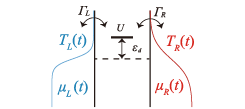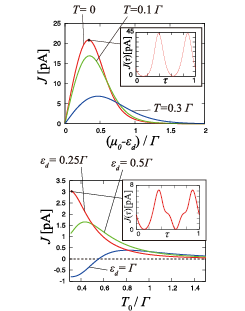Temperature-Driven and Chemical-Potential-Driven Adiabatic Pumping in Coherent Electron Transport
Kato Group
Adiabatic pumping is a process by which a finite charge(heat) current is induced under periodic slow modulation of external parameters. This phenomenon has been studied for a long time as an important issue in time-dependent quantum transport. In addition to charge current, recent developments in the field of nanotechnology have enabled us to measure heat current under temperature bias in a controlled way. This development has stimulated both of the theoretical and experimental investigations of the thermodynamics properties of mesoscopic devices. Recently, adiabatic heat pumping induced by temperature modulation has been discussed in phonon transport via molecule junctions [1], and temperature-induced transport has been discussed in contexts of thermoelectric transport and nonequilibrium thermodynamics [2].

Fig. 1. Schematic figure of the system considered in this study.

Fig. 2. The upper panel: Estimated pumping current under the chemical-potential modulation described by μL(t)=μ0+μ1cos(2πft) and μR(t)=μ0+μ1sin(2πft) for μ1=0.5Γ and TL=TR=0, 0.1Γ, 0.3Γ as a function of (μ0-εd)/Γ. Here, εd and Γ are an energy level and a linewidth of the QD, respectively. The lower panel: Estimated pumping current under the temperature modulation described by TL(t)=T0+T1cos(2πft) and TR(t)=T0+T1sin(2πft) for T1=0.3Γ, μL=μR=0, and εd=0, 0.1Γ, 0.3Γ as a function of T0.
We have studied adiabatic charge pumping driven by modulation of thermodynamic variables of the reservoirs in the coherent regime [3]. We have considered charge pumping via a single-level quantum dot (QD) coupled to reservoirs with time-dependent temperatures and chemical potentials (see Fig. 1), and have shown that charge pumping is indeed possible when Coulomb interaction is introduced in the QD. We have calculated pumping current up to the first order of U (the strength of the Coulomb interaction in the QD) by the perturbation theory based on the Keldysh formalism, employing the method of the thermomechanical field to describe temporal changes of the temperatures.
We show the estimated average pumping current in Fig. 2 for a pumping frequency f=1GHz. The upper panel of Fig. 2 shows the pumping current under the chemical-potential modulation described by μL(t)=μ0+μ1cos(2πft) and μR(t)=μ0+μ1sin(2πft) for μ1=0.5Γ and TL=TR(=T)=0, 0.1Γ, 0.3Γ as a function of (μ0-εd)/Γ, where εd and Γ are an energy level and a linewidth of the QD, respectively. The lower panel of Fig. 2 shows the pumping current under the temperature modulation described by TL(t)=T0+T1cos(2πft) and TR(t)=T0+T1sin(2πft) for T1=0.3Γ, μL=μR=0, and εd=0, 0.1Γ, 0.3Γ as a function of T0. In the present estimate, we have assumed the symmetric coupling to the two reservoirs, and have set the strength of Coulomb interaction as U=Γ. As seen in Fig. 2, the estimated pumping current is of order of 1-10pA, which is measurable in a standard experimental setup. The pumping current is proportional to both the frequency f and the Coulomb interaction U in the present calculation, and therefore is reduced if f and U are taken as smaller. In the chemical-potential-driven pumping, we have shown that the pumping current is related to the first energy derivative of the spectral function (the local density of states in the QD) at low temperatures. Similarly, in the temperature-driven pumping, we have shown that the pumping current is related to the second energy derivative of the spectral function at low temperatures; the sign change of the pumping current for εd=Γ in the lower panel of Fig. 2 originates from this fact. The insets of Fig. 2 show the time-dependence of the current induced by the modulation at the maximum of the pumping current in the main panel.
We have also shown that the present charge pumping originates from a time delay in a change of the occupation number of the QD with respect to modulation of the reservoirs. This time delay is understood by a relaxation time determined by circuit elements characteristic of coherent electron transport under external AC modulation of voltages and temperatures.
In this study, we have studied charge pumping in a simple setup with a single-level QD up to the leading order of Coulomb interaction. It is a future problem to formulate adiabatic pumping in the presence of a strong Coulomb interaction. Also, with the present formulation, we would be able to tackle general pumping in coherent transport from the viewpoint of the nonequilibrium thermodynamic properties of mesoscopic devices.
References
- [1] J. Ren, P. Hänggi, and B. Li, Phys. Rev. Lett. 104, 170601 (2010).
- [2] T. Yuge, T. Sagawa, A. Sugita, and H. Hayakawa, J. Stat. Phys. 153, 412 (2013).
- [3] M. Hasegawa and T. Kato, arXiv:1601.05812 (2016).
